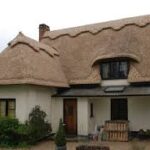Thatching can be a good roofing option, depending on your specific needs and circumstances. Here are some of the key benefits and drawbacks to consider:
Benefits of Thatching
- Aesthetic Appeal:
- Thatch roofs have a unique, rustic charm that can enhance the visual appeal of buildings, especially in rural or traditional settings. They are often favored for their picturesque and historical look.
- Insulation:
- Thatch provides excellent thermal insulation, keeping buildings warm in winter and cool in summer. This natural insulating property can lead to energy savings.
- Sustainability:
- Thatch is an environmentally friendly material, as it is made from renewable resources like straw, reeds, or other vegetation. It has a low carbon footprint and is biodegradable.
- Acoustic Properties:
- Thatch has good sound insulation properties, reducing noise from rain and external sources, which can make interiors quieter and more comfortable.
- Flexibility and Adaptability:
- Thatch can be used to create roofs with complex shapes and designs that might be challenging or costly with other materials. Its flexibility allows for creative and intricate architectural features.
Drawbacks of Thatching
- Fire Risk:
- Thatch is highly flammable, making it a fire hazard. Modern thatch installations often include fire retardants and protective barriers, but the risk remains higher than with non-combustible materials.
- Maintenance:
- Thatch roofs require regular maintenance to ensure their longevity and performance. This includes periodic re-thatching, repairing damaged sections, and keeping the roof free from debris and pests.
- Cost:
- The initial cost of thatching can be high due to the specialized skills required for installation. While the materials themselves might be inexpensive, labor costs can be significant.
- Pests and Rot:
- Thatch can attract pests like birds, rodents, and insects, which may damage the material. It is also susceptible to rot and mold if not properly maintained and if exposed to excessive moisture.
- Weather Vulnerability:
- Thatch can be more vulnerable to extreme weather conditions compared to some modern roofing materials. Heavy rain, snow, or wind can damage the roof if it’s not well-constructed and maintained.
Conclusion
Thatching can be an excellent roofing choice if you value its aesthetic appeal, insulation properties, and sustainability. It is particularly suitable for rural or traditional buildings and for those looking to maintain historical authenticity. However, the potential fire risk, maintenance requirements, and initial costs are important factors to consider. Ensuring proper installation and regular upkeep can mitigate some of the drawbacks, making thatch a viable and attractive option for many.
We have a network of service providers that install lightning protection systems, thatch roof tiles and provide thatch fire retardant services

